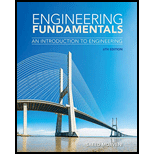
Concept explainers
Calculate the mean, standard deviation, and variance for the given measured values.
Answer to Problem 8P
The mean, variance, and standard deviation for the given values of screw length are
The mean, variance, and standard deviation for the given values of pipe diameter are
Explanation of Solution
Given data:
The given measured values of screw length and pipe diameter are shown below.
| Screw Length (cm) | Pipe diameter (in.) |
| 2.55 | 1.25 |
| 2.45 | 1.18 |
| 2.55 | 1.22 |
| 2.35 | 1.15 |
| 2.6 | 1.17 |
| 2.4 | 1.19 |
| 2.3 | 1.22 |
| 2.4 | 1.18 |
| 2.5 | 1.17 |
| 2.5 | 1.25 |
The total number of measured values,
Formula used:
From equation 19.1 in the textbook, the formula to find mean for any sample is,
Here,
From equation 19.5 in the textbook, the formula to find the variance is,
From equation 19.6 in the textbook, the formula to find standard deviation is,
Calculation:
Calculation for Screw length:
Substitute all the value of screw length for
Substitute all the value of screw length for
Substitute all the value of screw length for
Calculation for pipe diameter:
Substitute all the value of pipe diameter for
Substitute all the value of pipe diameter for
Substitute all the value of pipe diameter for
Therefore, the mean, variance, and standard deviation for the given values of screw length are
Conclusion:
Thus, the mean, variance, and standard deviation for the given values of screw length are
Want to see more full solutions like this?
Chapter 19 Solutions
ENGINEERING FUNDAMENTALS
- What is the approximate axial force in girder EF of the frame shown? Use the portal method. a. 32 kN b. 60 kN c. 12 kN d. 20kNarrow_forwardDetermine the vertical reaction at C for the beam shown and support settlements of 1" at B and ¼" at C. a. 27.0 k b. 28.3 k c. 43.7 k d. 21.0 karrow_forwardWhat is the horizontal reaction component at D for the frame shown? a. 75.00 kN b. 91.67 kN c. 70.31 kN d. 4.69 kNarrow_forward
- Find the vertical reaction at D for the frame shown and a settlement of 50 mm at support D. a. 80.7 kN b. 112.5 kN c. 144.3 kN d. 6.51 kNarrow_forwardDetermine if the W14x 22 beam will safely support a loading of w= 1.5 kip/ft. Theallowable bending stress is oallow = 22 ksi and the allowable shear stress is Tallow = 12 ksi.arrow_forwardWhat is the fixed end moment FEMAB for the beam shown with a settlement of 1.2 in. at support B? a. -102.7 ft-k b. -95.2 ft-k c. -307.7 ft-k d. 279.8 ft-karrow_forward
- Suggest an optimum footing size and shape (minimum area footing), if the vertical loading (includingthe weight of the footing) is 40 kips, and the soil has the following characteristics: c=200 psf, φ=370,and γ=120.0 lb/ft 3. Constraints of the solution are: the maximum dimension of any side of thefooting is 10 ft, and the depth of embedment is between 2 and 4 ft.arrow_forward15.6 A mountain stream flows over a rocky streambed. Apply the Limerinos and Chezy equations to calculate the discharge. The stream has an intermediate rock size d 84 of 30 cm, an average depth of 2.1 m, a slope of S = 0.0037, and a width of 52 m. In SI units, what is the discharge? a. 85, b. 120, c. 160, d. 240, or e. 410.arrow_forwardThe maximum bending moment for the beam shown is positive. a. True b. Falsearrow_forward
- I have complete structural and architectural plans for a 3-storey residential house, and I need help computing the quantity of materials per floor for concrete, masonry (CHB walls), and reinforcing steel bars. Below are the extracted values from the plans. Can you please guide me step-by-step per floor on how to compute the following: Concrete volume for footings, columns, beams, slabs, and stairs CHB wall quantity in pieces (after deducting openings) and mortar volume Rebar estimates per structural elementarrow_forwardI have structural and architectural plans for a 3-storey residential house, and I need to compute the quantity of materials for concrete, masonry (CHB walls), and reinforcing steel bars. Based on the following extracted values from the plans, can you help me compute the estimated material quantities? ps. i just want to make sure my answer were correct.arrow_forward11.16 A circular billboard with a diameter of 4 m is exposed to the wind. Estimate the total force exerted on the structure by a wind that has a direction normal to the structure and a speed of 20 m/s. Assume T = 10°C and p = 101 kPa absolute. Use Table 11. in §11.3arrow_forward
 Engineering Fundamentals: An Introduction to Engi...Civil EngineeringISBN:9781305084766Author:Saeed MoaveniPublisher:Cengage Learning
Engineering Fundamentals: An Introduction to Engi...Civil EngineeringISBN:9781305084766Author:Saeed MoaveniPublisher:Cengage Learning
